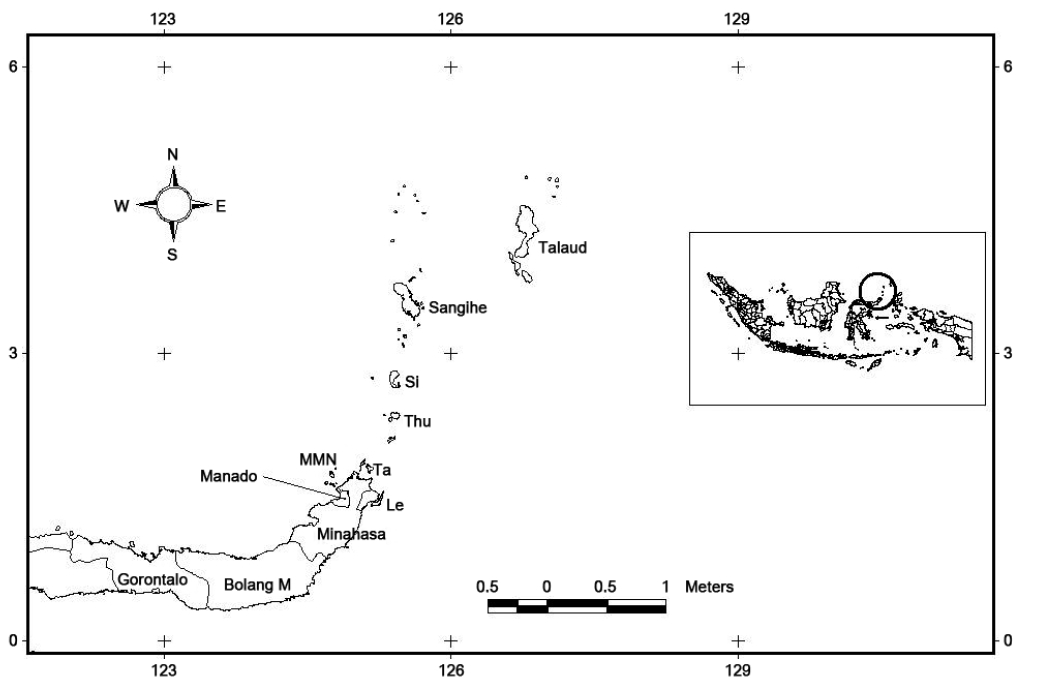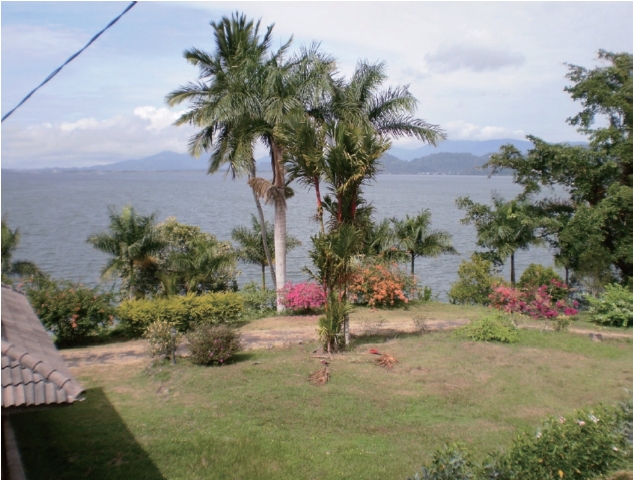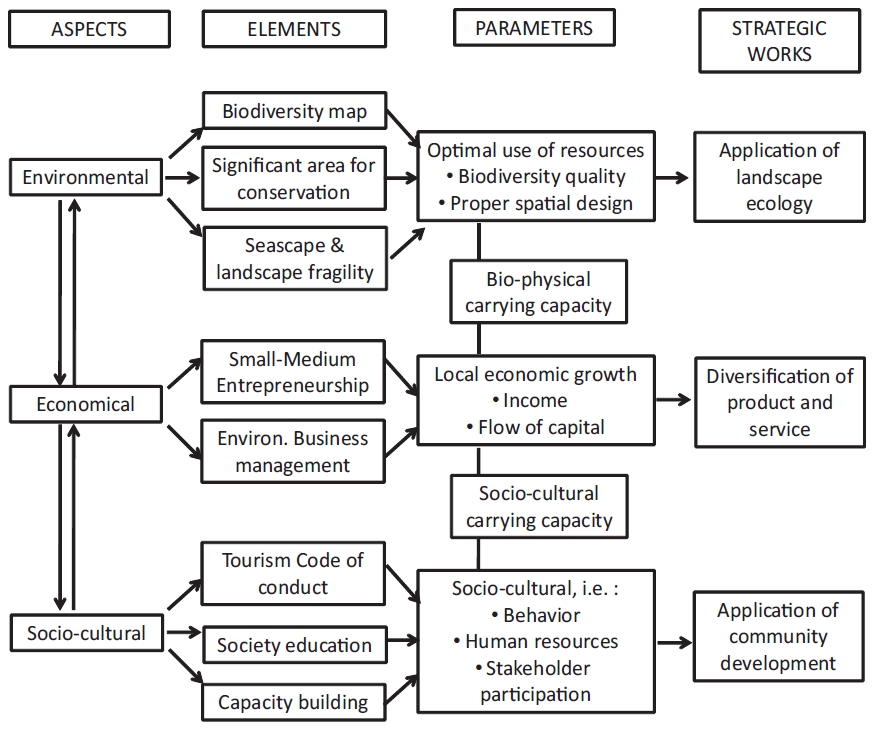



The term biodiversity refers to the variability of lives on earth. Biodiversity comprises all the natural resourc-es that provide useful goods and services for mankind. While biodiversity has a number of important functions, recently, many of them have been heavily threatened due to human activities (Naumann 2001). Large-scale deforestation in many developing countries has signifi-cantly decreased the degree of biodiversity. According to Rhee et al. (2004), illegal logging and harvesting are also recognized as significant factors to rapid biodiversity ex-tinction. Moreover, poor natural resources management and practices are continuing to decrease biodiversity in many developing countries (Fox et al. 2000, Kartodihardjo and Supriono 2000). Loss of biodiversity means loss of re-sources and ecosystem services and therefore threats hu-man sustainability in the biosphere (Cunningham et al.2003, Rhee et al. 2004).
The Indonesian tropical rain forest exhibits a high de-gree of biodiversity. The total number of known higher plant species is over 23,975 species. The number of mam-mal species is known be about 515 species. There are 929 known species of birds from the Indonesian archipelago. A total of 745 reptile species and 278 amphibian species are known from Indonesia. Fish comprises approximately 4,080 species from marine and freshwater ecosystems (BAPPENAS 2003). Many of them are endemic to Indone-sia. Unfortunately, the rate of degradation has increased dramatically (Hakim and Nakagoshi 2008). The forces leading to deforestation vary from place to place within Indonesian islands. However, it is clear that logging and forest conversion of tropical rain forests have caused a rapid decrease in the forest cover in Indonesia (Kartodi-hardjo and Supriono 2000, BAPPENAS 2003, Rhee et al. 2004).
It is generally assumed that forest degradation is re-lated to poverty. Many communities in poor areas de-pend on illegal hunting for food. Poor people cut trees for sale in illegal markets. Moreover, absence of scenario for sustainable use of biodiversity also becomes the crucial factor that leads to deforestation. According to scholars, deforestation and biodiversity decrease will not improve unless the basic economic needs are improved (Roe et al. 2003, Kumar 2010). Consequently, developing effective strategies to provide jobs and increasing economic ben-efits for local people will bring about positive changes to biodiversity conservation. Hence, ecotourism has been proposed as an important strategy. Ecotourism has been recognized to have a significant contribution to the devel-opment of local economy (Damanik et al. 2005, Drumm and Moore 2005). Ecotourism is a form of sustainable tourism and can be particularly appropriate for develop-ing countries. The benefits of ecotourism within the idea of biodiversity conservation are gradually being acknowl-edged and identified. For many tourism destinations, tourism supports the local economic development, pro-motion of local culture, education, and the quality of life of local people. As a sustainable business, ecotourism is a promising alternative to local and national development as well as being a clean and environmentally friendly business. Thus, ecotourism is probably the most effec-tive strategy for many developing countries (Kinnaird and O'Brien 1996, Ross and Wall 1999, Gunn and Var 2002, Hakim et al. 2008, 2009, Hong 2011).
In the context of Indonesia, ecotourism has been stud-ied extensively because of its economic benefits and con-tributions to local development. In the case of Indonesia, the main challenge is not only related to the country’s natural capital richness, but also global tourist visitation trends (Damanik et al. 2005, Hakim and Nakagoshi 2008, Hakim 2011). In the first semester of 2010, Asia was the most visited region in the world. At the same time, inter-national tourist arrival to Bali, the main tourism destina-tion in Indonesia, increased by 9%. Tourism to natural environments has been growing significantly. Although a number of tourism studies have been implemented, a comprehensive study related to the importance of biodi-versity, tourism planning and development has not been carried out. Over time, an increasing number of tourists will be a threat to biodiversity. Recent discussions about biodiversity and tourism in Indonesia have highlighted the needs for more research and study to understand the links between biodiversity, tourism and sustainability (Hakim et al. 2008).
North Sulawesi Province (NSP) is one of the popular tourism destinations in eastern Indonesia. Tourism has been growing since the 1970’s and nowadays its contribu-tion to provincial earnings is considered significant. Re-cently, favorable conditions for the development of tour-ism in NSP have been due to the socio-political factors. Local government plays an important role in developing tourism events, establishing new vacation sites and pro-moting NSP as a new world’s tourism destination (Whit-ten et al. 1987). Biodiversity and environmental factors contribute significantly to the tourism sector. Neverthe-less, much of the research carried out on tourism has been focused on the economical aspect and less attention has been paid on the ecological aspect. Very few study of the role of biodiversity on the tourism development has been conducted in South Sulawesi. Therefore, the aims of this paper are to 1) document the recent status of biodiversity, 2) review the recent status of tourism characteristics in NSP, 3) determine the impact of tourism on biodiversity, and 4) discuss the strategy to achieve sustainable tourism development in NSP.
The NSP located in the northern part of Sulawesi Island, Indonesia, covers an area of approximately 15,273.10 km2. This province consists of the longest and thinnest pen-insula in the southern part of Sulawesi Island. Small is-lands encompass Manado Tua, Bangka, Talise, Bunaken, Mantehage, Lembeh, Siau, Tagulandang, Karakelang, Karabuan, and Salibabu (Fig. 1). This province contains a diverse ecosystem ranging from coastal to mountainous ecosystems. The mean annual temperature is 26℃ and rain fall ranges from 1,133 mm to more 1,562 per annum. This province has more than 1,837 km of coastline that incorporates many diverse types of ecosystems (Whitten et al. 1987, BPS Sulut 2009).
North Sulawesi comprises important regions of tropical rain forest in which biological diversity is extremely high. Various factors such as soil chemistry, soil water, climate, and altitude contribute significantly to diversity and com-position of natural vegetation. Nevertheless, the recent continual growth of human population is reported to be the greatest threat to the luxurious forest in NSP. Since
the end of the 1970’s, the landscape of north Sulawesi has been transformed through deforestation. In the 1990s, degraded forest in NSP reached 510,384 ha (FWI 1996, Fox et al. 2000). Among the forest types, the highest rate of deforestation occurred in the upper forest (Whitten et al. 1987). The economic crisis at the end of 1997 led to a se-vere shortage of forest. Timber extraction became one of the main sources of income in the situation of economic crisis (Kartodihardjo and Supriono 2000). Moreover, the massive growth of logging (forest concession rights,
Biodiversity research on North Sulawesi was begun by A.R. Wallace in 1859, who spent more than four months observing some species of birds and mammals. According to Wallace (2000), tropical forest of North Sulawesi con-tains high diversity of insects, mammals and birds. The most comprehensive information related to the ecology of Sulawesi was compiled by Whitten et al. (1987). Addi-tional information related to the biodiversity of Sulawesi is provided in several reports by Indonesian Institute of Science (LIPI), Department of Forestry, Birdlife Interna-tional, World Wide Fund for Nature (WWF), and other conservation bodies. Indonesia government, Non-gov-ernmental Organization (NGO) and conservation agency realized that NSP is a crucial place for the world’s biodi-versity conservation (BAPPENAS 2003). Efforts to com-plete the biodiversity status of North Sulawesi principally show that it is a critical habitat of biodiversity in the world.
The historical roots of species diversity and endemism in North Sulawesi can be traced to the process of island establishment in the late Pliocene (3 Ma ago). Because of the long history of geological processes, Sulawesi has
[Table 1.] Conservation area in North Sulawesi Province
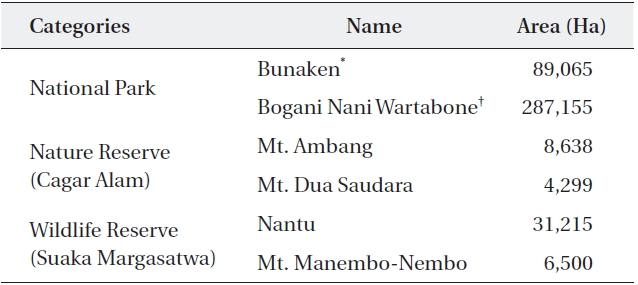
Conservation area in North Sulawesi Province
come to possess diverse and unique flora and fauna. This high diversity encompasses a large number of endemic and rare species (Whitten et al. 1987). While biodiversity information of Sulawesi Island is relatively completed, lit-tle is known in detail about the number of plants, reptiles and amphibians in NSP (Table 2).
The most famous animals are the Babyrusa (
Sulawesi is home to about 332 species of birds. Among the bird species living in NSP, Maleos (
[Table 2.] Number of identified and endemics species in Sulawesi and North Sulawesi Province (NSP)
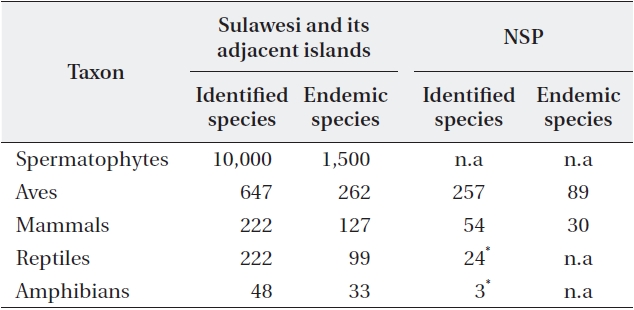
Number of identified and endemics species in Sulawesi and North Sulawesi Province (NSP)
nificant in that it will create a sound basis for the avifauna conservation.
Discovery of new species has been continuously re-ported from NSP. The most spectacular discovery was the living Coelacanths,
NSP has a large number of active volcanoes such as Mt. Ambang (1,689 m), Mt. Soputan (1,783.7 m), Mt. Karange-tang (1,827 m), Mt. Ruang (714 m), Mt. Submarine (1,922 m), Mt. Awu (1,340 m), Mt. Lokon (1,580 m), Mt. Mahawu (1,331 m) and Mt. Tangkoko (1,149 m). Mountains pro-vide critical habitats for animals and plant species. For in-stance, Mt. Tangkoko is the home of endemic species such as crested black macaques
The northern area of NSP consists of 124 islands. The area has an extensive coral reef ecosystem. Bunaken Ma-rine National Park is the most diverse coral reef ecosys-tem in the world. The park consists of five islands, namely Bunaken, Manado Tua, Mantehage, Naim and Siladen. Invertebrates, especially Cnidarians are abundant in the shallow-waters of North Sulawesi Sea (Ross and Wall 1999, de Vantier and Turak 2004). Approximately 2000 species of fish and 50 genera of coral reefs have been identified in Bunaken. Significant marine mammals in the sea wa-ter of NSP include Sea cows, Whale and Dolphin (Whitten et al. 1987). This richness of marine creatures has made NSP the Marine Golden Triangle of the world. However, there are still serious problems including illegal harvest-ing, bombing and tourism activities.
The factors responsible for the decrease in biodiversity include habitat loss, pollution, and illegal logging. Tim-ber extraction was one of the main sources of income. The most commonly extracted species were
The importance of tourism in NSP is widely acknowl-edged. Tourism has become one of the most significant sectors contributing to the economic development (Ross and Wall 1999, Walker et al. 2000, Damanik et al. 2005). This area was toured by those who enjoyed learning di-rectly about the nature and biodiversity of North Su-lawesi. The number of international tourists rose from 16,930 visitors in 2004 to 29,715 visitors in 2009. Most of the international tourists visiting North Sulawesi come from Europe (29%) especially Germany, Netherlands, England, and Italy. Asian tourists (24%) come from Sin-gapore, Malaysia and the Philippines. Approximately 21% of East Asian tourists come from Japan, South Korea and Taiwan. A smaller proportion comes from the USA (9%) and Australia (5%). There are signs that tourism sectors maybe starting to emerge. According to statistical data, registered local tourist guides increased from 80 people in 2006 to 145 people in 2009. A number of tour and travel businesses increased from 62 in 2006 to 81 companies in 2009. This is followed by the increased number of Taxis which was recorded as 25 units in 2006, but reached 200 units in 2009. Significantly, the number of hotel rooms grew from 1,151 in 2006 to 2,227 units in 2009. These tour-ism sectors contribute significantly to the NSP’s econom-ic development (BPS Sulut 2009).
Since 1980, the provincial government has coordinated an ambitious effort to prepare NSP as one of the world’s tourism destination. Parallel to this mission, the opening of new tourism destination began in the 1990’s. Within the last two decades, many new tourism facilities and at-tractions have been flourished in NSP. In 2008, seven five-star hotels started to build in Manado. Most of them have been set up to meet the international standard. The num-bers of tourism destinations have risen from 81 sites in 2001 to 394 sites in 2006. In 2009, there were 545 tourism destinations throughout NSP (Pangemanan et al. 2002, BPS Sulut 2009). This development led to a remarkable era of interest in tourism development in NSP. Nonethe-less, the existence of crucial links between tourism, social and environmental attributes are not yet clear.
Principally, nature-based tourism is dominant in NSP. Small islands such as Bunaken, Siladen, Mantehage, and Sangihe-Talaud islands offer spectacular spots to explore marine biodiversity and experience coastal recreation (de Vantier and Turak 2004, Kusen and Tioho 2009). NSP has many lakes, but only few have been promoted as nature based tourism destinations. The most visited lakes were Lake Tondok and Lake Tondano while several lakes such as Linow, Moat, Buyat, Wungangaan and Mokobang were not developed as ultimate tourism destinations (Pange-manan et al. 2002). Lake Tondado in Minahasa Regency is the biggest lake in NSP and has been cited in many tourist brochures and magazines as a prime tourism destination. Nevertheless, poor management of the lakes has been causing rapid sedimentation, exotic species invasion and eutrophication. Over the period of 1939-1992, the area of the lakes has decreased from 5,600 ha in 1939 to 4,600 ha in 1992. Sedimentation process has changed the depth of the water from 40 m in 1934 to 15 m in 1996 (Sittadewi 2008). Besides Tondano, degradation of natural tourism attractions has occurred significantly in some lakes in NSP.
Coral reef ecosystem is the basis for nature-based tour-ism in NSP. There are at least 120 dive sites distributed in North Sulawesi. The most number of dive sites are found in Bunaken Island. About 9,000 divers per year come and enjoy NSP’s underwater landscape. However, increasing number of divers are influencing to conservation of ma-rine ecosystem. The impact of underwater activities to coral reefs has led to coral disturbance. In Bunaken and adjacent waters, de Vantier and Turak (2004) recorded regarding significant tourist interactions to coral reefs, such as touching, holding, standing on corals, and harass-ments, which potentially caused coral damage.
In 2000, The North Sulawesi Tourism Promotion Board was established with the mission of developing and pro-moting NSP as a premier tourism destination. Attempts have taken place to hold international events such as World Ocean Conference (WOC), Coral Triangle Initiative (CTI Summit) and Sail Bunaken in 2009. The notion of tropical marine biodiversity richness has been an impor-tant theme used to invite more international tourists. As a result, the impact was significant in economic earnings, but its positive contributions to social and environmental sectors were debatable.
>
Tourism impact to biodiversity
Tourism activities are likely to contribute to a series of problems. For instance, tourist facilities contribute to the exploitation of water resources and produce a large amount of waste. Tourism in natural areas can alter veg-etation diversity and structure, introduce non-native spe-cies, disrupt animal migration, affect wildlife behaviors and population and pollute water resources. NSP has experienced a tremendous tourism growth in the recent decades. Walker et al. (2000) showed that tourism devel-opment may have negative consequences not only on biodiversity but also on social, economic, political and cultural aspects. There are mechanisms of tourism im-pacts on biodiversity which are summarized in Table 3.
The direct potential mechanisms have been studied by local and international researchers in order to protect biodiversity of tourism destinations and its surrounding areas (i.e., Kinnaird and O’Brien 1996, Kasmidi et al. 1999, Walker et al. 2000, de Vantier and Turak 2004, Kusen and Tioho 2009, Paulsen 2009). Increased tourist demand to resources will stimulate systemic exploitation of NSP’s biodiversity. Growth of tourist accommodation will tend to extraction of timber and non-wood forest products (i.e. bamboo and rattan) in order to meet the civil construc-tion needs. Illegal collection of coral reefs as souvenirs has been reported widely in many coastal tourism destina-tions in the world, particularly in NSP.
Indirect potential mechanism of tourism to Biodiver-sity has received less attention in NSP. Principally, the im-pacts of global tourism growth are many. An invasion of tourists into a fragile area will potentially alter ecosystem’s integrity, structure and composition. An increase of tour-ist number can potentially stimulate uncontrolled rapid development, pollution, and wild habitat degradation. Scholars point out those tourists as outsiders are able to make changes to local social organization and behavior, and systematically lead to indigenous system extinction (Walker et al. 2000, Roe et al. 2003, Weaver 2005).
There is a growing concern in tourism regarding the increasing severity of coastal degradation in tourism de-velopment. The required of land for marinas, hotels and tourism complex facilities were the causes of deforesta-tion in coastal areas. Such conversion has increased the pressure on the remaining coastal forest. Kasmidi et al. (1999) reported regarding the huge coral and mangroves tree exploitation in 1972 to establish trans-Sulawesi High-way. Tourism accommodations significantly became har-bors of non-native species. In NSP, there are numerous introduced plants species found in hotel’s parks and gar-dens such as
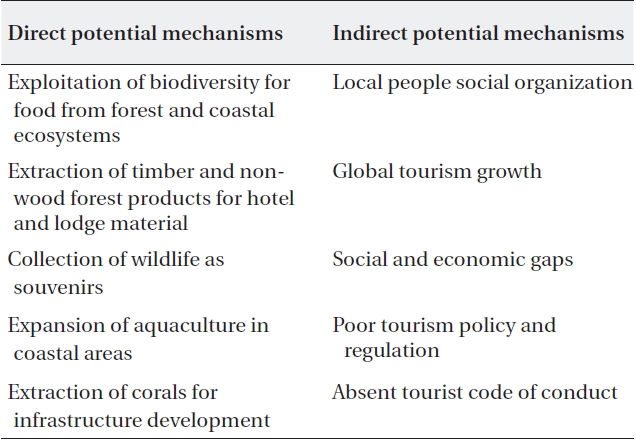
The type of potential mechanisms of tourism impacts on biodi-versity in North Sulawesi Province
Lack of adequate biodiversity management in tour-ism destination areas has been recognized as a serious problem in recent years in NSP. The major point of the problems, however, was the abundance of visitors in con-servation areas. A recent study by de Vantier and Turak (2004) in Bunaken suggested that diving in coral reefs has destroyed coral reefs significantly. Bunaken was visited by numerous visitors and experienced coral reef distur-bance. Nowadays, the most suffered corals are branching and foliose growth-form corals such as
The negative effects of tourism on the wildlife biology and ecology have been described by Reynolds and Braith-waite (2001). In NSP, Kinnaird and O’Brien (1996) report-ed that tourist activities may have changed primates’ be-haviors. Observations by Paulsen (2009) in
>
Challenges to sustainable tourism in North Sulawesi
These days, sustainable tourism has become a crucial issue in the tourism industry. According to World Tourism Organization, World Travel and Tourism Environment Research Center, Earth Council (1996), sustainable tour-ism is characterized by an optimal use of resources in a sustainable manner and with respect to socio-cultural authenticity of local people. Moreover, sustainable tour-ism should be able to provide socio-economic benefits to all stakeholders. Sustainable tourism emphasizes an open and wide participation of all stakeholders. Scholars argue that sustainable tourism will become the key to enhance economic growth and biodiversity conservation as well as community development in many developing countries (Gunn and Var 2002, Drumm and Moore 2005, Weaver 2005). Therefore, it is crucial that tourism planner under-stand the environmental, socio-political and economical aspects. Such understanding provides opportunities to develop more efficient and effective actions. Principally, it should be understood that the idea of biodiversity con-servation cannot be separated from any tourism planning or development.
In the next few decades, tourism is likely to play an important role in North Sulawesi. The main challenge for sustainable tourism, however, is reduction of overall factors which can lead to biodiversity disturbance. In the perspectives of landscape ecology, the most important point in selecting a new tourism destination system is the anticipation of biodiversity destruction. According to Hong et al. (2007), landscape ecology has been widely acknowledged as an important approach in spatial plan-ning, including tourism issues. Consequently, mapping biodiversity, both spatial and temporal, is a crucial step in every sustainable development scenarios. In NSP, how-ever, such integrative schema to plan land uses based on biodiversity content is absent and should be overcome. It is particularly relevant in the recent trend since the sta-tistical data clearly indicate the power of biodiversity in tourism industry.
High level of biodiversity has several implications for tourism development in NSP. Sustainability requires biodiversity conservation and resources management. Diversified destination products that include tourism events are also required. Biodiversity is necessary not only for the development of tourism attractions, but also for the consumption needs of tourists. Linking biodiversity, economy and social concepts are crucial for tourism des-tination planning and development (Gunn and Var 2002, Hakim et al. 2009). In such a case, however, the informa-tion on the recent biodiversity levels in North Sulawesi is limited due to the lack of comprehensive survey efforts. This limitation should be solved systematically. Effective tourism management can only be successful if it is based on the comprehensive information of the biodiversity status of the target area. In terms of tourism destination management, it is important to know the species diversity and its population structure in and around the destina-tion site.
Another issue that requires attention is the control of tourist number and activities. Every year, more than 9,000 visitors enter Bunaken and its adjacent waters. There is a positive correlation between diver activity and coral reef disturbance in Bunaken as well as between tourist con-tact intensity and primate’s behavior and physiology in Tangkoko Nature Reserve (de Vantier and Turak 2004, Ku-sen and Tioho 2009, Paulsen 2009). Therefore, managing tourists seems to be the best policy towards sustainable destination in NSP.
Local people’s role in tourism planning and decision making is less obvious in NSP. Design for tourism plan-ning and implementation in NSP therefore should involve the local community. According to Gunn and Var (2002), sustainable tourism should stress the importance of con-servation of biodiversity and participation of the local people. Recognition of local people in tourism planning and implementation is evident in many regions in the world. For instance, harmonious indigenous landscapes which are used as tourism attractions are often results of traditional management which is closely allied in the life of local people. Since biodiversity is closely linked with local people and tourism, it provides opportunities to enhance NSP as an authentic, competitive and sustain-able tourism destination. Therefore, local people of NSP should be encouraged and trained to take advantages of tourism.
The vulnerability of sustainable tourism in NSP is also related to the different perspectives among stakehold-ers. Conservationist, community, local government and tourism stakeholders typically have different views and perspectives of biodiversity conservation and sustainable tourism planning. Perspectives depend on the interest of each group. This situation can lead to conflicts among stakeholders. Therefore, the process by which regional tourism planning and development are drawn should in-volve the stakeholders.
>
Conclusion and recommendation
Sustainable tourism deals with the integration of en-vironmental, economic and socio-cultural aspects. The schema for sustainable tourism in NSP can be concep-tualized in Fig. 3. It is emphasized that the provision of biodiversity conservation is the most vital element and a prerequisite for tourism success. Any nature-based tourism implementation in NSP largely depends on the availability and quality of biodiversity. In the absence of any biodiversity conservation program, tourism will con-tribute to chemical and biological pollution, habitat deg-radation and resources exploitation. No tourism project is likely to be sustainable unless it involves proper bio-diversity conservation scenarios. In order to meet such needs, NSP should implement several strategic issues, namely mapping biodiversity, designing areas to accom-modate biodiversity conservation, and protecting fragile seascape-landscape. Applications of landscape ecology would provide excellent work.
Developing and increasing small-medium entre-preneurship (SME) has become significant in order to enhance local economic aspects. SME will allow and stimulate local entrepreneurs and enterprises to grow. Importantly, SME will be able to reduce unemployment, poverty and extensive uses of resources. Doing business differently means reducing stress to particular resources. Such economic schema will increase direct purchases from the local farmer and therefore will help farmer to de-velop their products. This schema will allow local people to receive economic benefits from tourism. Principally, however, environmental business should be implement-ed with the objectives to ensure tourism products and services meet environmental standards and consensus. For this reason, diversification of tourism products and services in NSP will become the key point of SME.
Achieving the well-being of local community is es-sential in sustainable tourism which can be attained by education and training programs. Such activities support public participation and will therefore accelerate tourism to achieve its sustainability goals. Codes of tourism prac-tices are essential to protecting indigenous systems and for the socio-cultural carrying capacity.
Making comprehensive nature-based tourism plan-ning requires an understanding of the biodiversity con-tents and relationship among its components. It is partic-ularly important since some of the complexity of tourism destination in tropical ecosystems arises from the variety of biodiversity components. If the area is disrupted by re-ducing and changing the biological integrity, it may take a long time to return. Threats to biodiversity hot spots in NSP may come from tourism developers, local govern-ments, tourist and community. Collaboration between local people and tourism developers, however, should be improved. Recent technology using spatial planning as a basis in decision making can be one of the integrative approaches to protect biodiversity from tourism develop-ment pressure. Hence, areas that contain valuable biodi-versity but are involved in tourism planning and develop-ment should be given consideration. The protection of the hot spot biodiversity sites requires a number of laws and policies. In NSP, to be sustainable, the tourism planning and development must be integrative and systematic.

